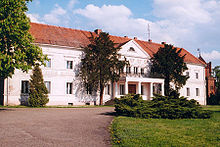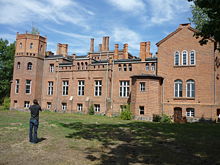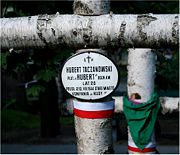
Taczanowski
Encyclopedia





Szlachta
The szlachta was a legally privileged noble class with origins in the Kingdom of Poland. It gained considerable institutional privileges during the 1333-1370 reign of Casimir the Great. In 1413, following a series of tentative personal unions between the Grand Duchy of Lithuania and the Kingdom of...
(nobility
Nobility
Nobility is a social class which possesses more acknowledged privileges or eminence than members of most other classes in a society, membership therein typically being hereditary. The privileges associated with nobility may constitute substantial advantages over or relative to non-nobles, or may be...
) family from Poznań
Poznan
Poznań is a city on the Warta river in west-central Poland, with a population of 556,022 in June 2009. It is among the oldest cities in Poland, and was one of the most important centres in the early Polish state, whose first rulers were buried at Poznań's cathedral. It is sometimes claimed to be...
bearing the Jastrzębiec Coat of Arms and the motto: Plus penser que dire. They took their name from their estate Taczanów in the 15th century and by the 19th century were among the leading magnate
Magnate
Magnate, from the Late Latin magnas, a great man, itself from Latin magnus 'great', designates a noble or other man in a high social position, by birth, wealth or other qualities...
s in partitioned
Partitions of Poland
The Partitions of Poland or Partitions of the Polish–Lithuanian Commonwealth took place in the second half of the 18th century and ended the existence of the Polish–Lithuanian Commonwealth, resulting in the elimination of sovereign Poland for 123 years...
-Poland. Members of the family are historically significant religious, political, scientific, and military figures. The family was granted the title of count
Count
A count or countess is an aristocratic nobleman in European countries. The word count came into English from the French comte, itself from Latin comes—in its accusative comitem—meaning "companion", and later "companion of the emperor, delegate of the emperor". The adjective form of the word is...
by King Friedrich Wilhelm IV of Prussia
Prussia
Prussia was a German kingdom and historic state originating out of the Duchy of Prussia and the Margraviate of Brandenburg. For centuries, the House of Hohenzollern ruled Prussia, successfully expanding its size by way of an unusually well-organized and effective army. Prussia shaped the history...
in 1857. The Austrian branch of the family, which spells the name Dassanowsky
Dassanowsky
Dassanowsky is the name of the Austrian branch of the Polish noble magnate family Taczanowski which came to Vienna in 1683 and has produced notable figures in Austrian civic and cultural life...
, came to Vienna with the forces of King Jan Sobieski during the Battle of Vienna
Battle of Vienna
The Battle of Vienna took place on 11 and 12 September 1683 after Vienna had been besieged by the Ottoman Empire for two months...
in 1683.
Notable members
Notable members include:- Jan Scibor Taczanowski (15th century-1468), voivode of Łęczyca c. 1437
- Andrzej Taczanowski (c. 1660-18th century), knight commander under King Sobieski during the Turkish Siege (Battle of ViennaBattle of ViennaThe Battle of Vienna took place on 11 and 12 September 1683 after Vienna had been besieged by the Ottoman Empire for two months...
) of 1683 - Rafael Taczanowski (18th century), head of the Jesuit Order in Poland
- Jan Taczanowski (1753-19th century), Lord High Steward of Trembowia
- Maksymilian Taczanowski (177?-1852), landowner and national revolutionary
- Count Alfons Anton Felix von Taczanow-Taczanowski (1815-1867), member of the Prussian House of Lords
- Władysław Taczanowski (1819-1890), zoologist
- Wladislaw von Taczanowski (1825-1893), politician; Prussian parliamentary representative
- Edmund TaczanowskiEdmund TaczanowskiEdmund Taczanowski was a Polish general, insurrectionist, member of the Taczanowski magnate dynasty , and Lord of the estate of Choryń in the province of Poznań....
(1833-1879), general and Polish patriot; in Italy with Giuseppe Garibaldi - Hubert TaczanowskiHubert TaczanowskiHubert Taczanowski, born 1960 in Poland, son of Stanisław and Maria Taczanowski and a member of the former magnate family Taczanowski from Poznań, is a US and UK-based motion picture cinematographer. A graduate of Cinematography at the famed Lodz Film School in Poland, Taczanowski has been the...
(1960- ), cinematographer
Selected Literature
- Gothaisches Taschenbuch der gräflichen Häuser, Perthes Verlag, Gotha 1857–1870
- P. P. Paprocki, Herby Rycerstwa polskiego, Krakow 1858
- Genealogisches Taschenbuch der Ritter- und Adelsgeschlechter (Brünner Taschenbuch), Brünn 1890
- Teodor Zychlinski, Zlota Ksiega szlachty polskiej, Poznan 1879–1908
- Stefan Graf von Szydlow-Szydlowski und Nikolaus R. von Pastinszky, Der polnische und litauische Hochadel, Budapest 1944
- Simon Konarski, Armorial de la noblesse polonaise titrée, Paris 1958
- Günther Berger, “Die Familie v. Dassanowsky: Die kaisertreue österreichische Linie des polnischen Grafenhauses Taczanowski zu Taczanow,” Krone und Reich: Zeitschrift des Verbandes der Österreicher zur Wahrung der Geschichte Österreichs, 1/2 1999, 13–15.
- Genealogisches Handbuch des Adels, Adelslexikon Band XIV, Band 131 der Gesamtreihe, C. A. Starke Verlag, Limburg (Lahn) 2003, .

